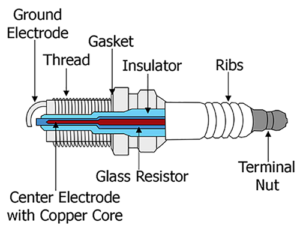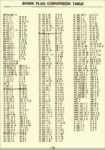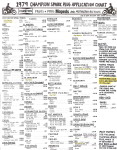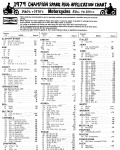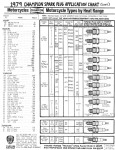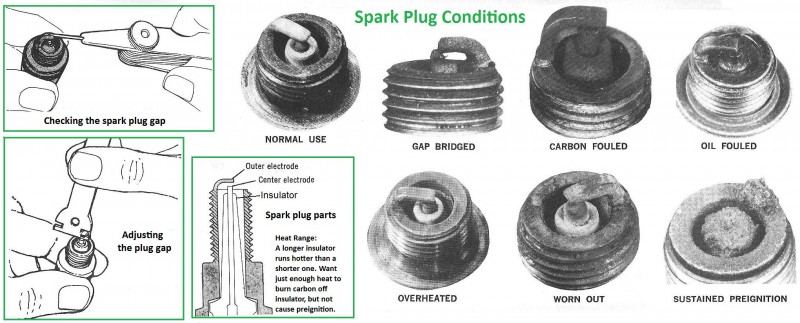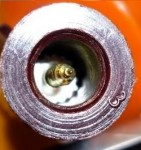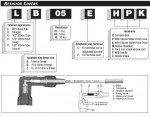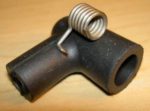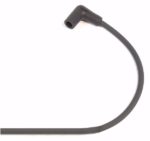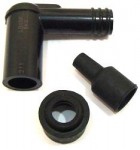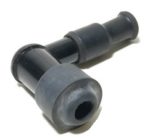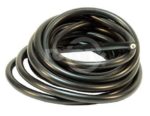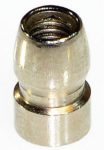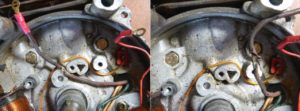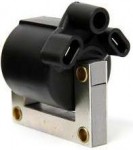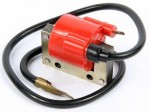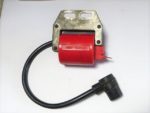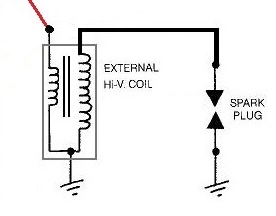Contents:
1. Spark Plugs
2. Spark Plug Info
3. Plug Caps and Wires
4. Spark Coils
1. Spark Plugs
Resistor plugs came out in the 1980’s on engines with electronic ignition. They have an R in the plug number, and are not specified in any 1970’s manual. They help protect the electronic unit from damage and reduce radio interference. Points ignitions do not need resistor plugs, but work fine with them. As the years go by more and more non-resistor plugs are becoming obsolete, in favor of resistor types. In 2019 NGK stopped making B5HS and B6HS, which are for most mopeds. Whenever those are specified, it is OK, and now required, to use BR5HS or BR6HS instead.
10 mm x 12.7 (½”)
3228 NGK C6HSA $3.50 =Champion
4629 NGK C7HSA $3.50 =Champion Z10YC =Bosch U4BC
2983 NGK CR6HSA none
4549 NGK CR7HSA $3.50 =Champion RZ10YC =Bosch UR3AS
This size is on very small 4-stroke motorcycle engines, 50-70cc per cylinder. C6HSA is on 1968-78 Honda Z50A, 1979-81 Honda Z50R. CR6HS is on 1982-99 Honda Z50R. C7HSA is on 1979-83 Indian, 1970-74 Honda PC50, PF50, 1980-81 Honda C70. CR7HS is on 1982-83 Honda C70 Passport.
12 mm x 12.0
6512 NGK D6HA $3.50 =Champion P8Y
7112 NGK D8HA none =Champion P7
This size is on small 4-stroke engines, mostly vintage Honda, 80 – 125cc. D6HA is on 1962-63 Honda CB92, 1964-69 S90, 1967-69 CL90, 1973-75 ST90. D8HA is on 1966-79 Honda CT90, 1963-66 CA200, 1964-66 CT200, 1966-69 CM91
12 mm x 19.0 (¾”)
7912 NGK D7EA none =Champion P8Y
2120 NGK D8EA none =Champion A8YC
7162 NGK DR8EA none =Champion RA8YC
This size is on small 4-stroke motorcycle engines, 80 – 500cc per cylinder. D8EA is on 1970-72 Honda CB100, CL100, 1973-74 Honda CL125, and many 1970’s Honda models.
12 mm x 19.0 (¾”) projected tip
5829 NGK DP8EA-9 $3.50 =Champion
4929 NGK DPR8EA-9 none =Champion
14 mm x 9.5 compact
5921 NGK BM6A $3.50 =Champion CJ11 = Bosch WS8E
6521 NGK BM7A $3.50 =Champion
This has a short reach (3/8″ = 9.5mm) and a short insulator, for compact or hand-held equipment. BM6A is on many bicycle motors, such as MX5 and Safari Fox. Most are hand-held gardening equipment engines.
14 mm x 9.5
3210 NGK B4 $3.50
0000 NGK BP5S $3.50
3510 NGK B6S none =Champion J8J
Champion J8J $2.00
3710 NGK B7S none =Champion J4J
Champion J4J $2.00
This has a short reach (3/8″ = 9.5mm), mostly for marine engines.
14 mm x 12.7 (½”)
4110 NGK B4H none
4210 NGK B5HS none =Champion L90C =Bosch W8AC =ND W16FS
3722 NGK BR5HS $3.50 = B5HS substitute, resistor type
7534 NGK B6HS none =Champion L86C =Bosch W7AC =ND W20FS
3922 NGK BR6HS $3.50 = B6HS substitute, resistor type
1052 NG. B6HS-10 none = B6HS with a wider gap 0.040″ not 0.020″
5110 NGK B7HS $3.50 =Champion L82C =Bosch W5AC =ND W22FS
5510 NGK B8HS $3.50 =Champion L87 =Bosch W3AC =Bosch W240T1
Bosch W240T1 $2.00
This size is mostly on small air-cooled 2-stroke motorcycle engines 50-150cc per cylinder. B4H is on 20mph 1.0hp Puch mopeds, and Angel, Speed Bird. B5HS is on mopeds with Laura M48 and M56 engines (20 and 25mph), Batavus, Trac mopeds with Minarelli V1 engines, including AMF 140, Baretta, Bianchi, Carabela, Cimatti, Concord (Fantic), Cosmo (some), Gadabout, General, Gitane, Motomarina, Maico, Motron, Safari, Testi, and mopeds with Puch engines (all 1.5 hp and some 2.0 hp), Puch, Sears Free Spirit, JC Penney, Murray, and mopeds with Sachs 504/1 and 505/1 engines, Columbia, General (and aliases), Hercules (Sachs), KTM Foxi, Kynast (Flying Dutchman), Lazer, Sparta, and mopeds with Solo engines, Columbia, Odyssey, and on many other mopeds Benelli, Bermuda (Flandria), Garelli (most), Jawa 207, Motobecane, Moto Guzzi, Tomos (A3 and A35 engine). B6HS is on Benelli, Bermuda (Flandria), Kreidler Flory, Motobecane (30mph 2hp), Peugeot 102 U3, 103 U3 (30mph 2hp), Puch 30mph 2.0 hp models Cobra, Magnum, Maxi, Sport MkII, Rizzato Califfo, on mopeds with Sachs 504/1 and 505/1 engines (30mph 2hp), Columbia, General (and aliases), KTM Foxi, Kynast, Lazer, Sparta, on mopeds with Solo engines (30mph 2hp) Columbia, Odyssey, and on mopeds with Laura engines (30mph 2hp), Batavus, Trac. B7HS is on 1988-92 Yamaha YSR50, and many other small vintage Yamaha’s.
You can see the progression here: 20mph bikes use heat range “4”, 25mph use “5”, 30mph use “6”, 45mph use “7”. This obeys the “spark plug heat range rule of thumb”. More restricted, less powerful engines need hotter spark plugs. Less restricted, more powerful engines need colder spark plugs.
14 mm x 12.7 (½”) projected tip
3511 NGK BP4HA none
3611 NGK BP4HS $3.50 =Champion L95Y =ND W14FP-U
0o0 ND W14FP-U $2.50 =Champion L95Y =NGK BP4HS
4111 NGK BP5HS $3.50 =Champion L95YC =Bosch W8BC
7331 NGK BP6HS $3.50 =Champion L92YC =Bosch W7BC or W6BC
7022 NGK BPR5HS none
7022 NGK BPR6HS none =Champion L92YC =Bosch WR7BP
BP4HA is on 1981-84 and 1987-91 Suzuki FA50 Shuttle. BP4HS is on 1979-88 Yamaha QT50 Yamahopper, 1981-00 Yamaha PW50, 1970-71 Suzuki F50 Cutlass, BP5HS is on 1977-83 Honda NC50 Express, 1978-83 Honda PA50 Hobbit
14 mm x 12.7 (½”) fine wire tip
7067 NGK BR7HIX $14.0
These super-plugs have a ultra-fine wire center electrode which lowers the voltage required. This makes a stronger spark at very low rpms, for easier starting. They also increase horsepower, typically ½ to 1 mph speed increase on a 30-40mph bike. The fine wire has a cap of precious metal, iridium, that resists erosion and allows the thin wire electrode to last thousands of miles. The down side is iridium costs more than platinum or gold, so the spark plug price is four times as much as a regular NGK spark plug. BR6HIX replaces BR6HS, BP6HS and B6HS. BR7HIX replaces BR7HS, BP7HS, and B7HS.
14 mm x 19.0 (¾”)
6410 NGK B5ES $3.50 =ND W16ES-U =Bosch W8CC
00 ND W16ES-U $2.50 =Bosch W8CC =NGK B5ES
7432 NGK B6ES $3.50 =Champion N5C =Bosch W7C
0000 Bosch W7C $2.00 =Champion N5C =NGK B6ES
1111 NGK B7ES $3.50 =Champion N4C =Bosch W5CC
2411 NGK B8ES $3.50 =Champion N3C =Bosch W4CC
0 Bosch W240T2 $2.00
2611 NGK B9ES $3.50 =Champion N2C =Bosch W3CC
5866 NGK BR5ES $3.50
4922 NGK BR6ES none
0000 NGK BR7ET $3.00 this obsolete plug has three outer electrodes, not just one!
5422 NGK BR8ES $3.50
This size is on many motorcycle engines, 4-stroke with over-125cc per cylinder, many 2-stroke air-cooled, and all 2-stroke liquid-cooled. B5ES is on Puch Dart and Maxi Plus (Austro Daimler). B6ES is on Garelli Monza GT.
14 mm x 19.0 (¾”) projected tip
7832 NGK BP5ES $3.50 =Champion N11YC =Bosch W8DC
0000 Bosch W8D $1.00 =Champion N11YC =NGK BP5ES
7333 NGK BP6ES $3.50 =Champion N9YC =Bosch W6DC
0000 Bosch W7D $2.00 =Champion N11YC =NGK BP6ES
1034 NGK BP7ES $3.50 =Champion N7YC =Bosch W5DC
2912 NGK BP8ES none =Champion N6YC =Bosch
7131 NGK BPR6ES none =Champion RN9YC =Bosch WR6DC
2023 NGK BPR7ES none =Champion RN7YC =Bosch WR5DC
This size is on many motorcycle engines, 4-stroke with over-125cc per cylinder, many 2-stroke air-cooled, and all 2-stroke liquid-cooled. BP5ES and B5ES are on mopeds with Morini MO1, MO2, M1 engines, including Bianchi, Colt, Cosmo, F. Morini, Italvelo, Intramotor, Italjet, Lem, Malaguti, Motobecane Sebring, Motomarina Sebring, Negrini, NVT, Pacer (Italtelai), Scorpion, and on Beta, and others.
14 mm x 19.0 (¾”) fine wire tip
0000 NGK BR7EIX $14.0
These super-plugs have an ultra-fine wire center electrode which lowers the voltage required. This makes a stronger spark at very low rpms, for easier starting. They also increase horsepower, typically ½ to 1 mph speed increase on a 30-40mph bike. The fine wire has a cap of precious metal, iridium, that resists erosion and allows the thin wire electrode to last thousands of miles. The down side is iridium costs more than platinum or gold, so the spark plug price is four times as much as a regular NGK spark plug. BR7EIX replaces BR7ES, BP7ES and B7ES.
2. Spark Plugs and Spark Checking
Spark Plugs are important. They’re also cheap and easy to change. The spark plug is the first thing you look at when a motor won’t start. Spark, compression, and fuel are the three main ingredients. Spark plugs come in different sizes and styles.
Spark Plugs are the #1 selling part on a moped. It’s good to have a spare. Spark plugs under normal conditions last for thousands of miles. A plug gets worn out when the sharp corners on the center electrode become rounded from erosion.
Fouling: A new spark plug might only last 1 mile in a “sick” engine, if the insulator becomes fouled, or coated with semi-conductive carbon (black instead of brown or white). Once the white porcelain insulator becomes fouled, the plug no longer functions.
Non-resistor: Vintage engines with points ignition, mostly before 1982, have non-resistor type spark plugs.
Resistor: Modern engines with electronic ignition, mostly after 1990, have resistor type spark plugs. The resistor inside the spark plug helps protect the electronic unit from burning out. But many modern motorcycles with electronic ignition do not need resistor plugs, and instead come with and specify non-resistor spark plugs.
Obsolete numbers: Many or most spark plug numbers specified in vintage owners manuals or application charts are obsolete. For example, in the 1979 Champion spark plug application chart below, most of the moped spark plugs specified are no longer made. The obsolete Champions are L89CM (=B5HS), N4 (=B7ES), N5 (=B6ES), and N9Y (=BP6ES). The only non-obsolete Champion is L82 (=B6HS or B7HS). In Bosch, at right is a list of 160 obsolete spark plugs, from the 1978 Puch Service Manual. Many or most of those upgraded spark plug numbers are now themselves obsolete. This situation can make it difficult to learn what modern spark plug is correct for a vintage motorcycle or moped.
Heat range errors: Fortunately there are spark plug cross-reference websites. But there are small errors in heat range that occur when spark plugs are “translated” from one brand to another, or from vintage to modern. The heat range of the replacement can be half of a number higher or lower than the original. For example Champion L82 translates to a NGK 6.5 heat range, half way between B6HS and B7HS. So some spark plug cross reference charts will say L82 = B6HS, some will say L82 = B7HS, and some will say L82 = B6HS or B7HS. It’s an error that looks bad on paper, but does not matter much.
Reading spark plugs: The condition of the spark plug tells you about the condition of the engine. A normal spark plug has a light brown coating on the white porcelain insulator, and sharp corners on the center electrode. A high mileage spark plug in a healthy engine looks the same but the electrode corners are rounded. Sparks like to jump from pointy things. A rounded center electrode or way too big a gap might make the engine hard to start.
Checking for Spark: Remove the spark plug, connect the cap to it, and lay it on the engine so the metal shell touches the engine. Turn the engine over either by pedal starting or by flicking the flywheel with your hand. Little momentary light blue sparks should be jumping the gap, making a “snap” sound each time the piston goes up and down. Modern CDI ignitions are hard to see in bright sunlight, so check for spark in the shade. A bright white, pink, or yellowish spark is bad. That usually indicates a fouled plug. Dim and blue is good, especially if the snap snap snap sound is loud.
3. Spark Plug Caps and Wires
Mopeds have copper core spark plug wires, that last “forever”. Cars have carbon core wires, that break down when they get old. Moped spark plug caps and ignition coils attach differently. Most screw into the end of the wire. Some spark plug caps have a pointed screw that pokes sideways into the wire near the end. The ends of the copper core get wore out from vibration or burned from arcing. Usually there is enough length to cut off the bad end and reuse the old wire. Always make a pilot hole with a something like a dental pick, before attempting to screw a cap onto a freshly cut wire.
C1 $4.00 Cap rubber poke-thru not screw-on, requires nut W5 on plug
C2 none Cap rubber, screw-on, no resistor, requires nut W5 on plug
C3 $7.00 Cap C1 with wire 7 mm x 29 inch, requires nut W5 on plug
C4 $6.00 Cap NGK LB05F, screw-on, 5k resistor, for no W5 on plug
C5 none Cap generic LB05F, screw-on, 5k resistor, for no W5 on plug
W1 $2.00 spark plug wire 7mm copper core black, per foot
W2 $1.00 spark plug wire 5mm copper core red, per foot
W3 $1.50 spark plug wire rubber boot for cap 7 x 12 mm
W4 $2.00 spark plug wire adapter sleeve 5 to 8mm with lip
W5 $0.25 spark plug terminal nut, comes with new plugs
4. Ignition Spark Coils (Transformers)
Be advised. These transformer coils do not go bad and completely loose spark. If you have no spark at all, and you replace the spark coil, 98% of the time you will still have no spark with a new coil. Even if you have power or voltage on the coil wire, yet no spark, replacing the coil will not help (because it needs interrupted power). Read more in Ignition Service Information
Initial troubleshooting: Performed first to eliminate some possible causes, using only fingers, eyes, pencil and paper.
- Eliminate the spark plug as the cause by testing for spark with another known good spark plug.
- Eliminate the spark plug cap and wire end, by removing the cap, exposing a short piece of braided copper, placing that between two cooling fins, and testing for spark. Sparks should jump 1/4 inch, or at least 1/8 inch. If no spark at all, then the cause is before the coil.
- Eliminate the points being adjusted badly, by observing with your eyes, as the wheel is turned around, that they open and close, and not always stay open or always stay closed.
- Eliminate the ignition timing being way off, by first finding which direction is forward, by moving the rear wheel forward and engaging the starter clutch, finding top dead center by using a pencil in the spark plug hole that touches the top of the piston, then seeing with your eyes if the points open a little before top, going in the forward direction.
-
Try cleaning the points. Without performing continuity tests with an ohmmeter, one last “hail Mary” attempt to get spark, easy and zero cost, is to clean the points with a strip of paper. Cut a strip of plain paper. Rotate the wheel until the points are open. Place the paper in between the points. Rotate the wheel gently until the points touch the paper gently, the pull the strip of paper out. It might have black or grey spots of burnt oil film. Recheck for spark. Realize that even though the points were just cleaned, they could still be “dirty”. A hard white coating can be on them, that paper does not wipe off. A points file, or a folded-into-two-sided piece of emery cloth, is needed to clean points, followed by paper to remove grit.
-
Beyond these tests an ohmmeter or continuity tester is required to test for loose, corroded, or pinched wires or dirty points, and more.
If these steps (tests) did not reveal the cause of “no spark” then there are more troubleshooting tests needed using an ohmmeter or continuity tester.
The details of that are in Ignition Service Information
Spark Coil Interchangeability: Ignition (transformer) coils for magneto-points ignition, like on vintage mopeds and off-road bikes, interchange except for the mount. So a German moped will run fine with an Italian coil, and an Italian moped will run fine with a German coil, attached temporarily with clip leads and wires. There are one-wire and two-wire types. On one-wire types, the mount is the “second wire”, and must be grounded to the frame. On two-wire types, either wire is the points wire, and the other must be grounded to the frame. So a Bosch 2-wire coil would replace any 1-wire coil, by adding a short ground wire, except for possibly the mount. The replacement might need a different mount or mount location. Or it might need to be mounted with on only mount bolt, instead of two.
H79 Dansi $75-$40 2 wire male blades, plug wire unscrews, 16-20 x 5 slots, made in Italy
H79A Bosch $60-$45 2 wire male blades, plug wire unscrews, 53 x 5 holes, made in Germany
H79B Dansi N/A 1 wire male blade, plug wire molded in,
H79G generic N/A 1 wire male blade, plug wire molded in, 32 x 5 holes, weaker than Bosch
H79M Motoplat $45 1 wire male blade, plug wire molded in, 15-25 x 6 slots, made in Spain
6309 CEV O0$55.0 1 wire screw post, plug wire molded in, 48 x 5 holes, made in Italy
6313 CEV $95-$65 1 wire male blade, plug wire molded in, 12-34 x 6 slots, made in Italy
6317 CEV $90-$65 1 wire male blade, plug wire molded in, 13-25 x 6 slots, made in Italy
A detachable wire that unscrews, is a big advantage. If your dog chews up your spark plug wire, you don’t have to buy a whole new coil (with molded-in wire). It is possible to solder on a new wire, but it will be prone to sparks leaking at the joint. As long as there’s no path to ground nearby, that it not a problem. Any of these coils will function well on any other type of moped or small vintage motorcycle with points and magneto ignition. They are just transformers with different mounting brackets. The Bosch coils seem to give the strongest spark, and are not sensitive to heat, and last “forever”. The only bad thing is the two mounting holes are usually too far apart. To get around this, you can use only one bolt with a nylock nut.

